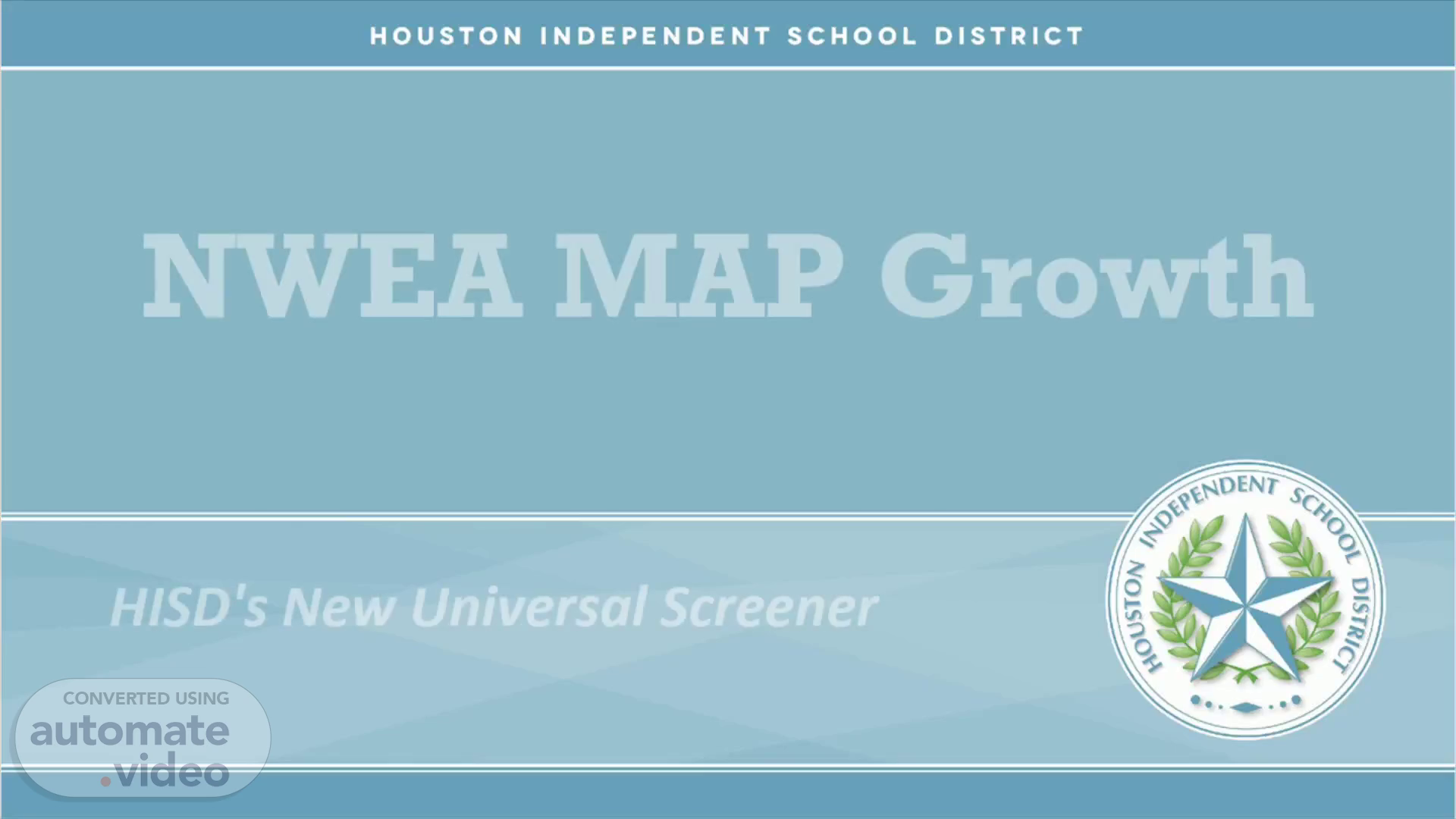Scene 1 (0s)
[Audio] Welcome to our session: N W E A Map Growth, H I S D's new universal screener..
Scene 2 (9s)
[Audio] The goals for today's learning are designed to ensure that leaders understand the Map Growth assessment and its use as H I S D's universal screener. We will look at the Map Growth overview, we will investigate who will take the N W E A Map Growth Assessments and when, and we will answer Why are we using Map Growth as our universal screener this year, and finally we will explore key terms..
Scene 3 (34s)
[Audio] We are using Map Growth as our new universal screener because it provides educators & families with specific information about their student's learning that will drive instruction with data to develop student goals. All of this will maximize learning because we will be able to maximize instruction with more rigor..
Scene 4 (54s)
[Audio] So why N W E A Map? Map identifies students' instructional levels, or Z P D. Map Growth provides more accurate results with a smaller standard error of measurement +- 3, and Map is tightly aligned to our Texas standards. This universal screener is the first to provide projections not only about Star performance but also the S A T and A C T..
Scene 5 (1m 20s)
[Audio] As we dive deeper into Map Growth assessments, I want you to bring your attention to these key terms: Rit score, adaptive assessment, zone of proximal development, normative data, and standard error of measurement. To interpret and analyze the assessment results and then communicate the results to students, their families, school leaders, etc., we will see these 5 commonly used Map Growth terms, but rest assured, we will help you make sense of all the testing terminology by the end of our session..
Scene 6 (1m 56s)
[Audio] Students will test in Reading, Math, & Science during the 2023-2024 academic school year. Students will take the universal screener three times per year at B O Y, M O Y and E O Y. The tests are about 40 - 43 questions long, and all test sessions are untimed, so we may allow students to test in multiple sessions..
Scene 7 (2m 20s)
[Audio] Map Growth assessments are computer adaptive, meaning that they adjust as the student tests so that we can accurately pinpoint the place in the learning continuum where the student is answering about 50% of the questions correctly. When the student answers a question correctly, the next question is a bit harder and more rigorous. Conversely, if the student answers incorrectly, the next question is easier. As the student progresses through the test, the standard error of measurement becomes smaller as the assessment narrows in on the student's performance level..
Scene 8 (2m 57s)
[Audio] So which assessments will be administered and who will take which test? Remember, all H I S D students will be assessed 3 times per year, at the beginning, middle, and end of the school year. Notice that all scholars from kindergarten to high school will be assessed in the Math Map Growth assessment. Shown here are the test names that will appear in our data export that we will discuss a little later. We will delve into this again later, but we want to bring to your attention that while there are also tests available for grades 6 through 8 in Spanish, this is not the language of instruction for those grade levels and is not offered as a choice for HISD testing at those grades..
Scene 9 (3m 42s)
[Audio] All scholars, grades two through high school, or English 2, will take the Reading Map Growth test. Notice, that students in grades two through 5 may test in either English or Spanish while there are also tests available for grades 6-8 in Spanish; however, this is not the language of instruction for those grade levels, so it is not offered as a choice for H I S D testing at those grades..
Scene 10 (4m 10s)
[Audio] And students in grades second through high school are also required to take the Map Growth Science / Biology tests. Note that Science tests are only available in English..
Scene 11 (4m 30s)
[Audio] Testing language is always a big discussion. We will defer to the multilingual department who will provide guidance on which tests students will take if they are enrolled in Dual Language or Bilingual programs; however, the math test should never be given twice and should only be given in the language of instruction..
Scene 12 (5m 1s)
[Audio] Remember, we said we'd come back to those all-important terms throughout today's session. Let's dig into the zone of proximal development (Z P D ). Z D P is the difference between what a student can do independently and what they can do with targeted assistance (scaffolding). Psychologist Lev Vygotsky coined this term in the 20th century to describe the ideal level where instruction is most beneficial for each student - just beyond their current level of independent capability..
